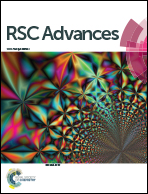Structurally confined ultrafine NiO nanoparticles on graphene as a highly efficient and durable electrode material for supercapacitors†
Abstract
The most significant challenge in the development of ultrafine oxide based supercapacitors is the poor microstructure stability due to the rapid agglomeration of the fine nanoparticles (NPs). Here, we developed novel amorphous MnOx structurally confined ultrafine NiO NPs (∼2.3 nm) supported on graphene, NiO@MnOx via a simple and facile self-assembly process with the assistance of microwave sintering. NiO@MnOx with a NiO : MnOx weight ratio of 1 : 0.2 achieves a high capacitance of 966 F g−1 based on total electrode materials and 3222 F g−1 based on active materials at a discharge current density of 2 A g−1. Remarkably, the materials retain 100% capacitance after 2000 cycles at a charge and discharge current of 10 A g−1. In contrast, the durability of ultrafine NiO NPs without MnOx confinement is very poor, with 94% of the capacitance lost under identical cyclic conditions despite the initial high capacitance of 3696 F g−1. The substantially enhanced capacitance, durability and high rate capacity contribute to the formation of a nanoporous and amorphous MnOx layer on ultrafine NiO NPs, which provides the extraordinary structural confinement and enhances the mass transfer process. The results provide a new strategy to develop highly efficient and durable ultrafine nanosized electrode materials for supercapacitors.


 Please wait while we load your content...
Please wait while we load your content...